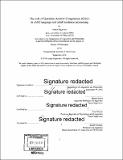| dc.contributor.advisor | Martin Hackl and Ken Wexler. | en_US |
| dc.contributor.author | Sugawara, Ayaka | en_US |
| dc.contributor.other | Massachusetts Institute of Technology. Department of Linguistics and Philosophy. | en_US |
| dc.date.accessioned | 2017-02-22T19:03:07Z | |
| dc.date.available | 2017-02-22T19:03:07Z | |
| dc.date.copyright | 2016 | en_US |
| dc.date.issued | 2016 | en_US |
| dc.identifier.uri | http://hdl.handle.net/1721.1/107090 | |
| dc.description | Thesis: Ph. D., Massachusetts Institute of Technology, Department of Linguistics and Philosophy, 2016. | en_US |
| dc.description | Cataloged from PDF version of thesis. | en_US |
| dc.description | Includes bibliographical references (pages 163-169). | en_US |
| dc.description.abstract | This dissertation investigates experimentally the role of Question-Answer Congruence (QAC, von Stechow 1990, Rooth 1985, 1992) in child language acquisition and adult sentence processing. Specifically, I present two case studies: sentences with "only" and sentences with the Rise-Fall-Rise contour (RFR, Jackendoff 1972). Case study 1 investigates a long-standing puzzle concerning the acquisition of "only." Since Crain et al. (1994), many studies report children display difficulties understanding sentences with pre-subject "only" while having no difficulty with pre-verbal "only." The current study manipulates the levels of QAC to study the puzzle. The results show that QAC plays a significant role in the asymmetry between Subject-only vs. VP-only, and more generally, both children and adults are sensitive to QAC, with congruence facilitating processing, and incongruence interfering with processing. We conclude that the cost of the accommodation of a sub-question to obey QAC is different for Subject-only and VP-only. I propose that the way information is packaged makes it easier to accommodate a set of questions asking about the object of the sentence, which makes it easier to process VP-only. We also showed that the extent to which QAC influences comprehension is different for children and adults. For children, QAC has a stronger influence than the syntactic condition on only. For adults, the syntactic condition is not violated. We suggest that the status of the syntactic condition regarding only is a factor that distinguishes children from adults in processing only. Case study 2 investigates whether children can construe the inverse scope interpretation, which children are reported to disfavor (Musolino 1998), with the RFR prosody, which is standardly taken to require inverse scope. The results show that both children and adults are sensitive to RFR and able to compute the implicature associated with RFR to disambiguate the inverse scope interpretation. As in the "only" study, QAC levels varied in the RFR experiment. However, the results revealed no effect of question type. This leaves an important open question: why QAC seems more active in children in determining the associate of only than in the determination of quantifier scope when the prosody makes the scope clear. | en_US |
| dc.description.statementofresponsibility | by Ayaka Sugawara. | en_US |
| dc.format.extent | 169 pages | en_US |
| dc.language.iso | eng | en_US |
| dc.publisher | Massachusetts Institute of Technology | en_US |
| dc.rights | MIT theses are protected by copyright. They may be viewed, downloaded, or printed from this source but further reproduction or distribution in any format is prohibited without written permission. | en_US |
| dc.rights.uri | http://dspace.mit.edu/handle/1721.1/7582 | en_US |
| dc.subject | Linguistics and Philosophy. | en_US |
| dc.title | The role of Question-Answer Congruence (QAC) in child language and adult sentence processing | en_US |
| dc.title.alternative | Role of Question-Answer Congruence in child language and adult sentence processing | en_US |
| dc.title.alternative | Role of QAC in child language and adult sentence processing | en_US |
| dc.type | Thesis | en_US |
| dc.description.degree | Ph. D. | en_US |
| dc.contributor.department | Massachusetts Institute of Technology. Department of Linguistics and Philosophy | |
| dc.identifier.oclc | 971249985 | en_US |
